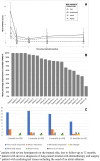Unilateral Magnetic Resonance-Guided Focused Ultrasound Lesion of the Subthalamic Nucleus in Parkinson's Disease: A Prospective Study
- PMID: 39295191
- PMCID: PMC11657072
- DOI: 10.1002/mds.30020
Unilateral Magnetic Resonance-Guided Focused Ultrasound Lesion of the Subthalamic Nucleus in Parkinson's Disease: A Prospective Study
Abstract
Background: Unilateral subthalamic nucleus (STN) ablation using magnetic resonance-guided focused ultrasound (MRgFUS) is being explored as a new treatment for asymmetric Parkinson's disease (PD).
Objectives: The aims were to study the efficacy and safety of this treatment in asymmetric PD patients and to characterize the lesions.
Methods: This prospective, single-center, open-label study evaluated asymmetric PD patients at 6 (n = 20) and 12 months (n = 12) after MRgFUS lesion of the STN. The primary outcome was the change in the Movement Disorders Society-Unified Parkinson's Disease Rating Scale, Part III (MDS-UPDRS III), score in off medication on the treated side and the adverse events (AEs) at 6-month follow-up. We also evaluated cognitive-neuropsychological changes, self-assessment of clinical improvement, and the correlation of the lesion volume with the motor outcomes.
Results: On the treated side, the MDS-UPDRS III score (mean difference = 13.8) and the scores in rigidity, bradykinesia, and tremor improved (P < 0.001) throughout the follow-up compared to baseline (at 6 months: rigidity mean difference = 2.8, improvement: 83.5%; bradykinesia mean difference = 6.0, improvement: 69.4%; tremor mean difference = 4.7, improvement: 91.5%). One patient had severe weakness in the treated hemibody, 1 had moderate dyskinesia, and 1 was in moderate confusional state that became mild (weakness) or completely resolved (dyskinesia and confusional state) at 6 months. The rest of the AEs were mild. We observed no clinically relevant changes in cognitive-neuropsychological tests. The percentage of ablation of the STN correlated with the improvement in the total MDS-UPDRS III and contralateral tremor scores (P < 0.05).
Conclusion: Unilateral MRgFUS lesion of the STN resulted in a significant motor improvement. We observed no persistent severe AEs, although mild, mostly transient AEs were frequent. © 2024 The Author(s). Movement Disorders published by Wiley Periodicals LLC on behalf of International Parkinson and Movement Disorder Society.
Keywords: Parkinson's disease; magnetic resonance–guided focused ultrasound; subthalamic nucleus (STN).
© 2024 The Author(s). Movement Disorders published by Wiley Periodicals LLC on behalf of International Parkinson and Movement Disorder Society.
Figures


Similar articles
-
Bilateral Lesions in Parkinson's Disease: Gaps and Controversies.Mov Disord. 2025 Feb;40(2):231-240. doi: 10.1002/mds.30090. Epub 2024 Dec 27. Mov Disord. 2025. PMID: 39726415 Free PMC article. Review.
-
Staged Bilateral MRI-Guided Focused Ultrasound Subthalamotomy for Parkinson Disease.JAMA Neurol. 2024 Jun 1;81(6):638-644. doi: 10.1001/jamaneurol.2024.1220. JAMA Neurol. 2024. PMID: 38739377 Free PMC article.
-
Prospective Long-term Follow-up of Focused Ultrasound Unilateral Subthalamotomy for Parkinson Disease.Neurology. 2023 Mar 28;100(13):e1395-e1405. doi: 10.1212/WNL.0000000000206771. Epub 2023 Jan 11. Neurology. 2023. PMID: 36631272 Free PMC article. Clinical Trial.
-
Magnetic Resonance-Guided Focused Ultrasound Thalamotomy in a Prospective Cohort of 52 Patients with Parkinson's Disease: A Possible Critical Role of Age and Lesion Volume for Predicting Tremor Relapse.Mov Disord. 2025 Mar;40(3):478-489. doi: 10.1002/mds.30093. Epub 2025 Jan 18. Mov Disord. 2025. PMID: 39825750 Free PMC article.
-
European Academy of Neurology/Movement Disorder Society-European Section Guideline on the Treatment of Parkinson's Disease: I. Invasive Therapies.Mov Disord. 2022 Jul;37(7):1360-1374. doi: 10.1002/mds.29066. Epub 2022 Jul 6. Mov Disord. 2022. PMID: 35791767 Review.
Cited by
-
Comparative Study of Focused Ultrasound Unilateral Thalamotomy and Subthalamotomy for Medication-Refractory Parkinson's Disease Tremor.Mov Disord. 2025 May;40(5):823-833. doi: 10.1002/mds.30159. Epub 2025 Mar 3. Mov Disord. 2025. PMID: 40028918 Free PMC article.
-
Focused Ultrasound Lesioning of the Subthalamic Nucleus for Asymmetric Parkinson's Disease in Japan.Mov Disord Clin Pract. 2025 Apr;12(4):547-550. doi: 10.1002/mdc3.14331. Epub 2025 Jan 9. Mov Disord Clin Pract. 2025. PMID: 39786311 No abstract available.
-
Bilateral Lesions in Parkinson's Disease: Gaps and Controversies.Mov Disord. 2025 Feb;40(2):231-240. doi: 10.1002/mds.30090. Epub 2024 Dec 27. Mov Disord. 2025. PMID: 39726415 Free PMC article. Review.
-
High-intensity focused ultrasound (HIFU) versus deep brain stimulation (DBS) for refractory tremor: team HIFU.Arq Neuropsiquiatr. 2025 Jul;83(7):1-4. doi: 10.1055/s-0045-1809660. Epub 2025 Jul 17. Arq Neuropsiquiatr. 2025. PMID: 40675616 Free PMC article. Review.
References
-
- Guridi J, Herrero MT, Luquin MR, et al. Subthalamotomy in parkinsonian monkeys Behavioural and biochemical analysis. Brain 1996;119:1717–1727. - PubMed
MeSH terms
LinkOut - more resources
Full Text Sources
Medical
Research Materials
Miscellaneous

